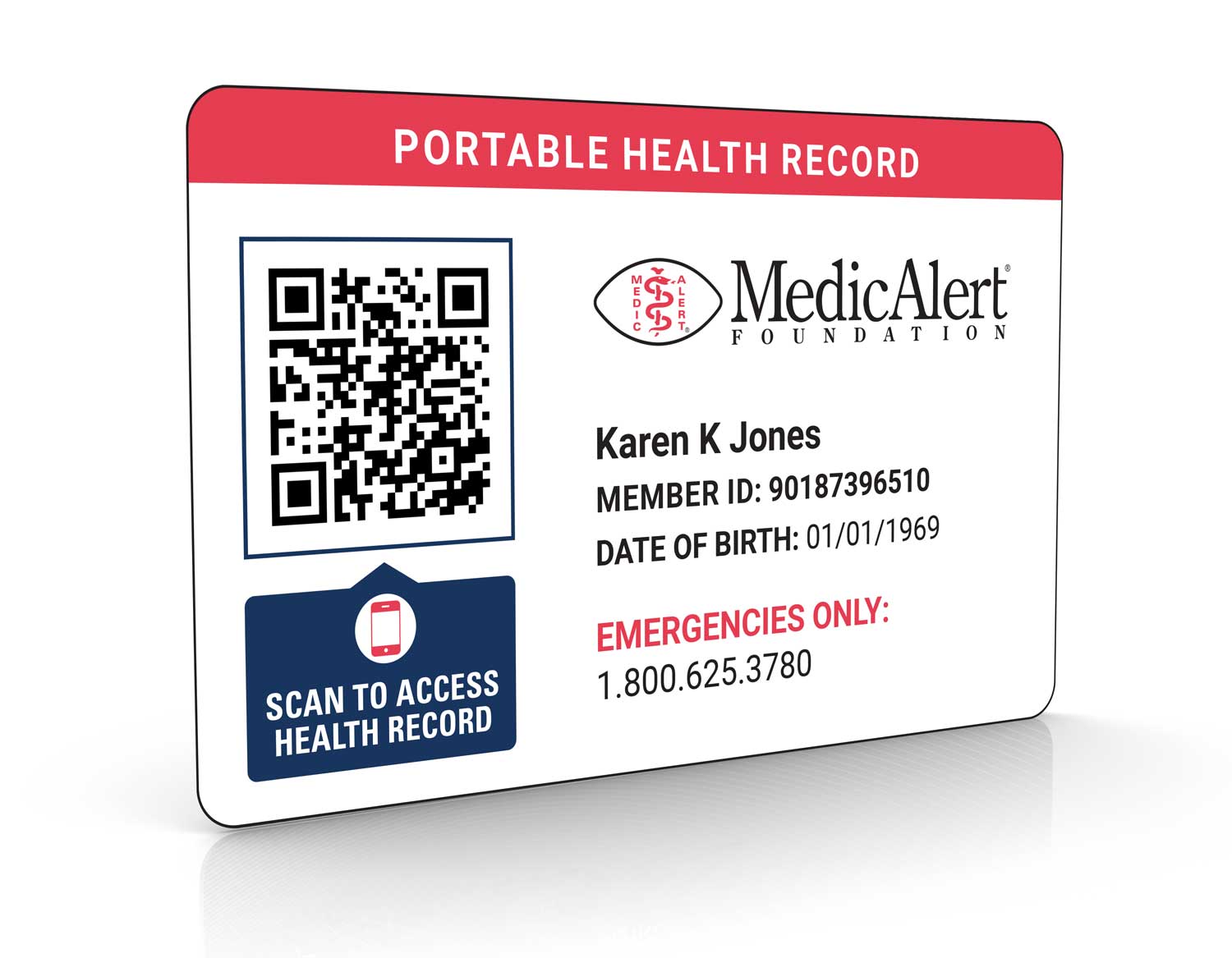Help others help you. Wear a medical alert ID bracelet or necklace engraved with important information for emergency responders and healthcare providers.
Centers for Disease Control & Prevention

Medical IDs for Barth Syndrome
The confidence to live with Barth syndrome
If a doctor has diagnosed your child with a genetic disorder, you probably have many questions and might feel overwhelmed by the new information you’ve received. This is also true for families who have just learned about their child’s Barth Syndrome diagnosis.
The good news is that although Barth Syndrome is rare, much has been discovered about it in the past several years. By learning these facts about the diagnosis, you can empower yourself with resources to help support your child to live the healthiest life possible.
How MedicAlert medical IDs for Barth syndrome protect you
One thing you shouldn’t worry about is what could happen if there’s an emergency. MedicAlert’s protection plans offer benefits that extend beyond the ID, providing safety and peace of mind for people living with Barth syndrome, their families and caregivers.

24/7 Emergency Response
Our team provides first responders the information they need to provide fast, accurate care.

Digital Health Profile
All your vital information, all in one place for you and your caregiver.

Emergency Contact Notification
In an emergency, we connect families so that no one is alone in a crisis.

Patient Instructions
Share the information that’s important to your care, such as use of rescue medications or contraindication for tests like MRIs.
Pair a medical ID for Barth syndrome with the protection plan that’s right for you.
What is Barth syndrome?
According to MedicAlert partner Barth Syndrome Foundation, the diagnosis of Barth Syndrome affects primarily those assigned as male at birth, and is typically passed from mother to son. It is a metabolic disorder rare enough that it can be difficult to diagnosis, since the symptoms can look like many other conditions and are different from one person to the next.
However, Barth Syndrome is a life-threatening diagnosis, and requires care from multiple specialists to ensure risks are managed as best as possible. Some common complications of Barth Syndrome include:
- Exercise intolerance
- Cardiomyopathy (a condition that weakens the heart muscle)
- Neutropenia (a condition affecting blood cells that fight infection)
- Muscle weakness and decreased muscle mass
- Growth delays
- Trouble eating due to problems with swallowing and chewing
- Abnormal cardiolipin (a fat in the blood that affects clotting)
- 3-methlygutaconic aciduria (a problem with the way the body makes energy)
What causes Barth syndrome?
Barth Syndrome’s effect on energy production and cells in the body can lead to several common symptoms. It’s important to be alert for these problems because they can indicate a need for prompt medical attention. Symptoms include:
- Abnormalities of skeletal muscles
- Delays in development of gross motor skills (movement)
- Decreased muscle tone
- Growth difficulties including failure to thrive (FTT)
- Intolerance to exercise and physical activity
- More frequent infections than peers
- Differences in facial features such as:
- A round face and full cheeks
- Broad forehead
- Larger ears than usual
- Deep-set eyes
- Prominent chin
Worsening fatigue can be a symptom of increased heart problems such as cardiomyopathy, a common complication of Barth Syndrome. It is also important to monitor for problems caused by difficulty eating or poor nutrition, and signs and symptoms of severe infections, which can be dangerous.
Your healthcare provider can help you know what to watch for in your child. Should your child need emergency medical care, a MedicAlert ID can act as your voice, ensuring all healthcare providers involved in your child’s care know about their Barth Syndrome diagnosis.
What are the signs and symptoms of Barth Syndrome?
Barth Syndrome is a genetic disorder, meaning it is inherited. As MedicAlert partner NORD explains, mutations in a gene called TAZ, which has an X-linked inheritance pattern, are known to be the cause of Barth Syndrome.
Because this gene is responsible for making a protein that affects mitochondria (the energy center of a cell), the parts of the body that need a high level of energy are especially affected. This includes muscles like the heart. Without the right kind of energy production, much of the body can be impacted by this condition, leading to weakness and other problems.
How is Barth Syndrome diagnosed?
To diagnose Barth Syndrome, doctors look at a combination of physical examinations, patient history and medical testing. This may include referral to specialists such as cardiologists to help reach a final diagnosis.
Some key things doctors look for when Barth Syndrome is suspected include:
Common characteristics of Barth Syndrome
These characteristics, or diagnostic criteria, must be present to diagnose Barth Syndrome:
- Growth delays
- Cardiomyopathy
- Neutropenia (low blood cell count)
- 3-Methylglutaconic Aciduria Type II (an increase in a substance involved in metabolism)
Health problems caused by Barth Syndrome
Along with the above diagnostic criteria, other health problems may be noted, including:
- Congestive heart failure, arrhythmias, and heart defects
- Neuromuscular problems including weakness, problems with
- posture, tone, gait, and strength or endurance
- Diarrhea or constipation
- Feeding problems
- Low bone density
- Physical malformations
Diagnostic testing for Barth Syndrome
If physical assessment and history reveals the problems discussed above, your child’s doctor may order additional testing which can include:
- Laboratory testing such as complete blood count and evaluation of
- 3-methylglutaconic levels
- Genetic testing to look for DNA evidence of Barth Syndrome
Echocardiogram (an ultrasound that looks at heart function)
What to engrave on MedicAlert medical IDs for Barth syndrome:
MedicAlert offers free custom engraving on all our medical IDs for Barth syndrome. Your new MedicAlert ID comes with free customized engraving so you can make certain details about your child’s Barth Syndrome diagnosis are included right where they can easily be seen by first responders. You should include important information such as:
The best things to engrave on a medical bracelet for Barth syndrome include:
- Your child’s medical history, including Barth Syndrome diagnosis
- Any medications your child takes
- Any allergies
- Other important details such as whether your child has an implanted cardiac device or surgical history

Sample engraving. Consult our team if you need help engraving your medical ID for Barth syndrome.
How do you treat Barth syndrome?
Although there is no cure for Barth Syndrome, treatment is available to help reduce symptoms and complications of the condition. These treatments include:
- Medications for heart failure
- Implantation of a defibrillator to treat serious arrhythmias
- Physical therapy to help with muscle weakness
- Early intervention for developmental delays
- Prompt treatment of infections with antibiotics
- Heart transplant in cases where heart failure isn’t responding to medications
It’s also important to work closely with your child’s medical team to make sure that any changes in their health are treated right away. This includes making sure anyone providing care for them understands what to watch for and when to alert you or a healthcare provider of problems.
Remember, because Barth Syndrome affects many parts of the body, it’s also critical that anyone treating your child for any medical emergency understands their diagnosis. This is where MedicAlert can help convey all important information even when you aren’t with your child and connect first responders with you so you can be by your child’s side quickly in an emergency.
MedicAlert Foundation is proud to partner with NORD to provide support, educational resources and tools to help those affected by rare disease live more safely and confidently.
How medical IDs for Barth syndrome combined with MedicAlert Membership provide peace of mind for those living with this condition
Learning that your child has a Barth Syndrome diagnosis can feel overwhelming. Thankfully, medical treatments continue to improve quality and length of life for those with Barth Syndrome. For even greater peace of mind, you can also join millions of others who have relied on MedicAlert for more than 65 years to safeguard their loved ones in situations where every second counts.
Be your voice: If you can’t speak for yourself, your ID will speak for you, informing others about your Barth syndrome and any medications you are taking.
Provide 24/7 emergency protection: Our team will relay all of our critical medical information to first responders in an emergency, no matter where or when it happens.
Keep you connected: You should never be alone in an emergency, that’s why MedicAlert will reach out to your emergency contacts when needed if you are unable to do so.
Enable you to live with confidence: The freedom to live your life with Barth syndrome, knowing that MedicAlert is there for you.
DISCLAIMER: THIS WEBSITE DOES NOT PROVIDE MEDICAL ADVICE. The information in this article is presented for educational purposes only and is not intended as a substitute for professional medical advice, diagnosis and treatment. Always seek the advice of a physician or other qualified healthcare provider for any questions you may have regarding a medical condition or treatment.








